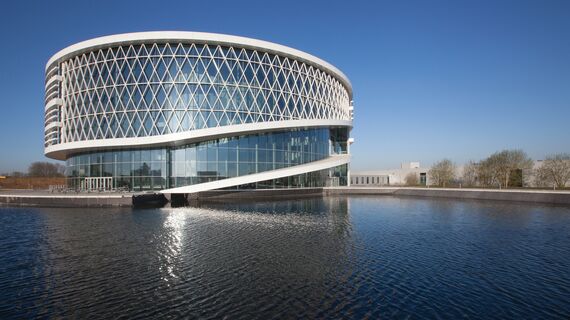- Archi + I & Crepain Binst Architecture
Tiensevest Office Complex
For several years, the tall provincial government building stood out as a lonely pioneer in the area between the railway and the ring road around Leuven, but this image is rapidly changing. Between the train station and the provincial government building, five semi-detached office blocks are rapidly taking shape in line with a design created by the architectural firms of Crepain Binst Architecture and Archi+I. This complex marks the start of a new office development in the vicinity of the Leuven train station.
This complex of office buildings, together with the provincial government building and the related development in the vicinity of the railway, is part of the realisation of the ‘Westelijke Spoorgeul (Western Railway Channel) Master Plan.’
This plan was prepared in 1997 by the City Design project team under the leadership of Marcel Smets, the Master Architect presently working for Flanders. The Master Plan pushed the outer border of the city to the area between the railway and the ring road around Leuven, with two anchor points at the far ends of the area: the provincial government building and the ‘Vlaams Administratief Centrum’ (Flemish Administrative Centre, VAC).
Glass base
The new office complex, which houses the KBC Bank, consists of five separate five-story buildings, supported by a 300 m long glass-enclosed base containing all the facilities associated with the KBC and the city of Leuven serving the public. This base is almost 5 m high and has a split-level construction on the railway side, offering a large field of view between the ring road and the railway. Beneath the base, there is a public bicycle storage facility with enough space for 5000 bicycles, intended for commuters, office employees and incidental users. Beneath the bicycle storage facility, there is an underground car park for 684 cars which can operate completely independently of the upper building. The area between the ring road and the office complex is reserved for a public park and a green promenade which will serve as a pedestrian walkway linking the Martelaarsplein in front of the train station with the Provincieplein higher up. Together, the base and the park provide a structural backbone for the office complex and vicinity.
Dynamic façade design
The five buildings in the overall complex are U-shaped, with the open and closed sides of the U alternately facing the ring road and the railway. The result is a dynamic and vibrant façade with alternating narrow, broad and recessed elements. In some places, the buildings are linked to each other by completely transparent walkways that seem to be floating in the air. Each building has two central core areas, around which most of the foot traffic is concentrated. The design is modular and based on a unit of 135 cm, allowing the offices to be laid out in various ways. In addition, the use of a modular unit ensures that the outer walls create a consistent and repeating pattern. The outer walls of the buildings are variations on a theme dominated by granite and glass, each with its own individual layout in terms of windows and relief. In addition, the outer walls each have their own colour: imperial red, snow white, olive green, crystal black and yellow gold. The granite surface has been roughened via water jetting, giving it a somewhat ‘weathered’ appearance.
Integrated solution
The windows of the five office blocks were designed around the CS 77 profile. In two of the buildings, granite elements were used to connect the outer walls to the window profiles, making it possible to use the standard profile system. In the other three buildings, it was not possible to use the granite elements for that purpose, and the architects therefore included an aluminium frame to serve as a connecting element between the outer wall and the window. In view of the large number of windows which had to be installed in this fashion, it made sense to search for an integrated solution. The construction company Hegge in Hamont-Achel took on the task of working together with the architects and Reynaers Aluminium to design a suitable variant of the CS 77 profile for this purpose. “The resulting design made it possible to clip the profile between the outer wall and the window to the window profile”, explains Wim Moors, project manager for Hegge, “which meant that no visible fasteners were needed such as screws etc. In addition, this resulted in significant time savings when it came to installing the large number of window profiles for the three buildings.”
Exclusivity
The attention paid to the design and installation of the window profiles is characteristic of the commitment demonstrated by the architects and building contractor in relation to this office complex. The details visible in the outer walls give the entire complex a certain degree of exclusivity and an ambience not generally associated with office buildings designed and built in conformance with market conditions. In addition, the positioning of the buildings, the colour palette used, and the consistent and repeating visual pattern of the outer walls create a feeling of openness and visual variation for the onlooker, in sharp contrast to the uniformity so characteristic of a great many large-scale office developments. In short, the entire complex is undeniably a positive addition to Leuven’s visual space.
Sisteme Reynaers utilizate
Părți interesate implicate
Arhitect
- Archi + I & Crepain Binst Architecture
Fabricant
- Hegge
Fotograf
- Louis Jongeneelen
Alte părți interesate
- Landsbeeck (Investors)
- Interbuild NV (General contractors)










